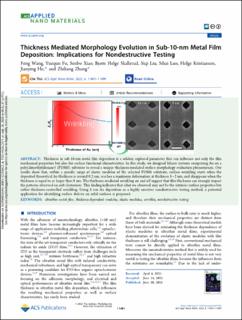Thickness Mediated Morphology Evolution in Sub-10-nm Metal Film Deposition: Implications for Non-destructive Testing
Wang, Feng; Fu, Yuequn; Xiao, Senbo; Skallerud, Bjørn Helge; Liu, Siqi; Luo, Sihai; Kristiansen, Helge; He, Jianying; Zhang, Zhiliang
Peer reviewed, Journal article
Published version
Permanent lenke
https://hdl.handle.net/11250/3080137Utgivelsesdato
2023Metadata
Vis full innførselSamlinger
Originalversjon
https://doi.org/10.1021/acsanm.3c01533Sammendrag
Thickness in sub-10-nm metal film deposition is a seldomly explored parameter that can influence not only the film mechanical properties but also the surface functional characteristics. In this study, we designed bilayer systems comprising Au on a polydimethylsiloxane (PDMS) substrate to reveal a unique thickness-mediated surface morphology evaluation phenomenon. Our results show that, within a specific range of elastic modulus of the selected PDMS substrate, surface wrinkling starts when the deposited theoretical Au thickness is around 0.2 nm, reaches a maximum deformation at thickness 1 ~ 2 nm, and disappears when the thickness is equal or larger than 8 nm. The thickness-mediated wrinkling on and off suggests that film thickness can strongly impact the patterns observed on soft elastomers. This finding indicates that what we observed may not be the intrinsic surface properties but rather a thickness-controlled wrinkling. Using 2 nm Au deposition as a highly sensitive non-destructive testing method, a potential application for identifying surface defects on solid surfaces is proposed. Thickness Mediated Morphology Evolution in Sub-10-nm Metal Film Deposition: Implications for Non-destructive Testing

